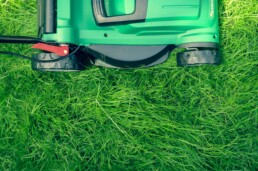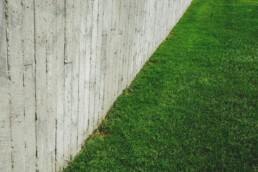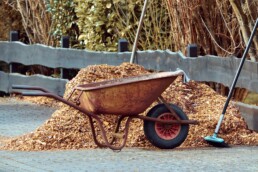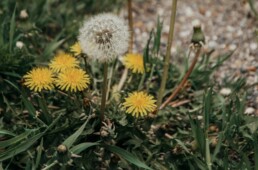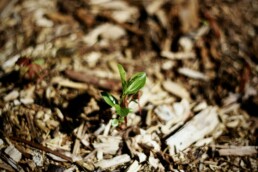Mulch Mowing vs. Bagging: What's Best for Your Lawn?
You might be surprised to learn that mulch mowing actually has nothing to do with what you may technically consider mulch! However, for those of us in the landscaping and lawn care industry, an often-debated topic is whether to mulch mow or bag your grass clippings. Each method has its own set of advantages and considerations. The question is: Which is best for your lawn? Let's find out.
Mulch Mowing: Nourishing Your Lawn Naturally
Mulch mowing involves finely chopping grass clippings and leaving them on the lawn to decompose. This process, often referred to as "grasscycling," returns valuable nutrients back to the soil. While you can use a mulching mower, which is specifically designed to chop your clippings into fine particles, a regular mower will work as well as long as the grass isn’t cut too short.
Benefits for Your Lawn:
- Nutrient Recycling: Grass clippings are rich in nitrogen, phosphorus, and potassium, which are essential for healthy grass growth. By mulching, you recycle these nutrients, which reduces the need for chemical fertilizers.
- Soil Health: Decomposing clippings improve soil structure, enhance moisture retention, and promote beneficial microbial activity.
- Less Time and Effort: Without the need to bag and dispose of clippings, you save time and reduce yard work.
What to Consider:
- Clipping Size: Make sure that your clippings are finely chopped to prevent them from clumping and potentially smothering the grass.
- Mowing Frequency: Regular mowing is essential to keep your clippings manageable and prevent thatch buildup.
Bagging Your Grass for a Well-Manicured Look
Exactly as it sounds, the practice of grass bagging means collecting your clippings during mowing, keeping the lawn clean and free of debris. This is typically done using either a lawnmower with a bagging attachment or manually raking up your clippings.
Benefits for Your Lawn:
- Aesthetic Appeal: Bagging provides a clean, manicured look, which is often preferred for formal lawns.
- Disease Management: Removing clippings can help prevent the spread of lawn diseases, especially if the grass is diseased.
- Weed Control: Bagging helps remove weed seeds, reducing the potential for new weed growth.
What to Consider:
- Nutrient Loss: Bagging can remove valuable nutrients from the lawn, which may necessitate additional fertilization.
- More Work for You: The process of bagging and disposing of clippings adds extra time and effort to lawn maintenance.
Which Should You Choose?
The decision between mulch mowing and bagging depends on your lawn's specific needs and your personal preferences:
- Opt for Mulch Mowing if you prioritize soil health, nutrient recycling, and reduced yard work.
- Choose Bagging if you desire a pristine lawn appearance, need to manage lawn diseases, or prefer to remove clippings for composting.
We Can Help!
Both mulch mowing and bagging have their place in lawn care. Understanding the benefits and considerations of each method allows you to make an informed decision that aligns with your lawn care goals. Remember, the best choice is one that suits your lawn's needs and your lifestyle.
What’s more, if you’re ever unsure about your lawn care routine or need an expert touch, Greendell can help. Contact us today for a consultation!
7 Gardening Ideas and Design Inspiration to Transform Your Outdoor Space
Great gardens don’t just happen—they’re carefully crafted with inspiration and intention. By designing a space that reflects your personality and lifestyle, you can create a garden that brings joy in every season. Ready to give your garden an upgrade? Here are seven inspiring gardening ideas to spark your creativity and help you craft a dream-worthy outdoor oasis.
7 Gardening Ideas to Upgrade Your Landscape
Vertical Gardens for Small Spaces
Don’t let limited space limit your gardening dreams. Vertical gardens are a fantastic solution for smaller cozier yards or urban environments. Integrate wall-mounted planters, trellises, or hanging pots around your patio or along a fence to create a lush green wall. Mix in colorful flowers with herbs and leafy greens for both beauty and functionality.
Themed Garden Spaces for a Unique Touch
Why settle for ordinary when you can design a garden with a theme? Find a garden style you like –– like a Japanese-inspired zen garden, an English cottage garden, or a Mediterranean oasis. Add decorative elements throughout for extra personality. Themed gardens bring character and charm to your outdoor space.
Pro Tip: Select plants native to your theme’s region for an authentic and easy-to-maintain landscape. Need help finding the right plants? We can help.
Edible Gardens for Beauty and Bounty
Gardens aren’t only for perennials and annuals. They can become a practical source of food and key ingredients for your next cooking inspiration. But a vegetable garden doesn’t need to be its own thing. Combine beauty and practicality by incorporating edible plants into your garden design. Mix vibrant vegetables, fruits, and herbs with ornamental flowers for a visually stunning and delicious garden.
Pro Tip: Plant companion plants, like marigolds with tomatoes, to naturally deter pests and boost plant growth. Then, add mulch for ideal plant growth!
Lighting for a Magical Nighttime Garden
Transform your garden into a magical space after sunset with creative lighting solutions. Outdoor lighting boosts curb appeal while helping your gardening ideas pop. Use string lights, solar-powered lanterns, and spotlights to highlight key features and make your garden dreamy –– all hours of the day.
Water Features for a Serene Atmosphere
There’s nothing like the soothing sound of running water to elevate your garden experience. Water features enhance a garden, making it truly feel like an escape. Consider adding a fountain, pond, or even a small cascading water feature to make your garden luxurious.
Native Plant Gardens for Eco-Friendly Landscaping
Native plants are plants that exist in our natural ecosystems in Indiana. Integrating native plants into your garden supports the existing ecosystems because they have developed important, often crucial, relationships with our wildlife. Embrace sustainability by designing your garden with native plants that thrive in your local climate. Plus, native gardens require less water and are more resilient to pests and diseases, making them a low-maintenance investment.
Outdoor Living Areas for Year-Round Enjoyment
Now that you’ve put all this work into cultivating a beautiful garden, it’s time to enjoy it! Maximize your garden’s potential by creating outdoor living areas. Add hardscaping or gravel pathways among your garden beds. Build a patio or deck and set up cozy seating arrangements, a dining space, or even a fire pit area. Make your garden a place you want to spend time in by blending lush greenery with practical designs.
Start Your Gardening Journey with Greendell!
Need any more gardening ideas? Start your journey with Greendell. Whether you’re starting from scratch or revamping an existing space, we can help you find the innovative landscaping solutions and products you need to bring your vision to life. Order the products you need, or visit our showroom for more design inspiration and expert advice!
djtzsfrw
Lawn Care for Beginners (in 5 Easy Steps)
Starting a lawn care routine can feel overwhelming if you’ve never maintained a yard before. But you don’t need to be a landscaping expert to achieve a healthy, green lawn. With just a few easy steps, we’re breaking down lawn care for beginners so you can transform your yard into a space you’re proud of. Whether you’re tackling your lawn solo or looking for expert help, Musselman can be your trusted guide.
Here’s a beginner-friendly guide to getting your lawn care on track:
Step 1: Test and Prepare Your Soil
Healthy grass starts from the ground up. Testing your soil helps you understand its pH and nutrient levels so you can give your grass exactly what it needs.
A Few Tips:
- Purchase an affordable soil testing kit from your local garden center (have you checked out ours?)
- Look for key indicators like pH balance (ideally between 6.0 and 7.0) and nutrient deficiencies.
- Add soil amendments as needed. Lime can raise pH, while sulfur lowers it. Integrating organic compost into your soil is great for boosting nutrients.
Step 2: Choose the Right Grass for Your Region
Not all grass types thrive in every climate. Picking the right grass will save you time and frustration down the line.
A Few Tips:
- Determine whether your region is best suited for cool-season or warm-season grasses.
- Cool-season grasses (like Kentucky bluegrass) are great for northern climates like Indiana.
- Consider a mix of grass types for a resilient, year-round lawn.
Step 3: Mow Regularly and Correctly
Mowing isn’t just about keeping your lawn tidy—it’s essential for healthy growth. But there are some right ways (and wrong ways) to mow.
A Few Tips:
- Set your mower blade to the right height. Most grass types do best when kept at 2.5 to 3 inches tall.
- Mow frequently enough that you never remove more than one-third of the grass height at a time.
- Keep mower blades sharp to avoid tearing the grass, which can lead to disease. Regular mower maintenance and cleaning can help ensure the best results.
Step 4: Water Wisely
Overwatering and underwatering are common mistakes for beginners. Proper watering keeps your lawn lush and strong.
A Few Tips:
- Water early in the morning to reduce evaporation and prevent fungal diseases.
- Aim for about 1 inch of water per week, including rainfall.
- Deep, infrequent watering encourages deeper root growth compared to shallow, frequent watering.
Step 5: Fertilize and Control Weeds
Feeding your lawn gives it the nutrients it needs to grow thick and green while weed control keeps unwanted invaders at bay.
A Few Tips:
- Apply a balanced, slow-release fertilizer in spring and fall.
- Spot-treat weeds rather than blanket spraying to protect your grass.
- Consider organic options if you’re concerned about chemicals.
Bonus Tip: Don’t Be Afraid to Ask for Help
If you’re ever unsure about your lawn care routine or need a professional touch, Greendell is here to help. Our experts can guide you through the process or take care of the heavy lifting so you can enjoy a beautiful yard without the stress. Contact us today for a consultation or to learn more about our network of landscaping experts. With Musselman by your side, you’ll be on your way to a lush, healthy lawn in no time.
10 Gardening Tips to Take Your Green Thumb to the Next Level
It’s peak gardening season in Indiana. Are you ready to tackle it? Gardening is more than digging in the dirt—it’s about creating a space that feels alive and vibrant. But cultivating the garden of your dreams takes some strategy. To help you take your green thumb to the next level, we’ve gathered our top 10 gardening tips for 2025. Let us be your guide.
Our 10 Gardening Tips for 2025
1. Plan Before You Plant
Before you dig into your project, take the time to plan. Get to know your outdoor space so you’re setting up your plants for success. Sketch out the layout, consider sunlight patterns, and group plants with similar needs together. A well-thought-out design ensures that your plants get the right amount of sun, shade, and water to flourish all season long.
2. Feed the Soil
Healthy plants start with healthy soil. For the best outcomes, test your soil to determine its pH and nutrient levels. Is it too acidic? Are you noticing any earthworms? If your soil needs some love, amend it with organic compost or high-quality mulch to improve structure and fertility. Try mixing mulch in with your soil! This addition can help retain moisture and regulate soil temperature, giving your plants the best environment to grow.
3. Choose the Right Plants
Placing plants at random can be a costly mistake. Get to know which plants thrive in your region, then select plants suited to your climate and soil type. Consider color, texture, height, and width to make your beds aesthetic to the eye. Consider how much shade or sunlight each patch of land will get through the day. Not sure where to start? Native plants are a great option because they’re adapted to your area’s conditions and require less maintenance. Or seek expert advice from a landscaping pro (ahem…like us!).
4. Water Wisely
Plants need water, right? Right. But overwatering is one of the most common gardening mistakes. Water deeply but infrequently to encourage deep root growth. If you can, water in the early morning to reduce evaporation and give your plants time to dry before evening, minimizing the risk of disease.
5. Mulch Like a Pro
A fresh layer of mulch not only looks fantastic but also offers practical benefits. Musselman’s premium mulch helps suppress weeds, retain soil moisture, and protect plants from extreme temperatures. Spread mulch 2-3 inches thick around your plants while avoiding letting it pile up against stems. Mulch will help your plants hold on to nutrients, stay moisturized, and protected from weeds.
6. Prune Regularly
Pruning keeps your plants healthy and encourages new growth. When you remove dead branches or buds, more nutrients and energy flows to the thriving parts of your plant. Cut away dead or damaged branches, thin out dense foliage to improve airflow, and shape shrubs and trees to your desired aesthetic. And remember: always use sharp, clean tools to make precise cuts and prevent damage.
7. Compost Your Clippings
Turn garden waste into gardening gold by starting a compost pile. Composting is a resourceful way to use up grass clippings, leaves, and kitchen scraps while supporting better garden health. These materials break down into nutrient-rich compost that can be mixed into your soil. What an eco-friendly way to reduce waste and give your plants a natural boost!
8. Keep Pests at Bay
Integrated pest management is the key to maintaining a healthy garden without relying heavily on chemicals. Introduce beneficial insects like ladybugs, use natural deterrents, and keep plants healthy to prevent pest infestations. Musselman’s landscaping materials can also help create barriers that deter pests.
9. Rotate Your Crops
If you grow vegetables, practice crop rotation to prevent soil depletion and reduce the risk of pests and diseases. Carefully move plants to a new spot each season to keep the soil balanced and your harvests plentiful.
10. Love Your Landscape
Your garden is an extension of your home, so take time to enjoy it. Add pathways, seating areas, or water features to create a welcoming space where you can relax and unwind. Not sure where to start or which materials are best? Schedule time with us to explore Musselman’s landscaping products so you can design the perfect outdoor retreat.
Ready to Grow? Let Greendell Help.
At Musselman, we’re here to support you every step of the way. From our premium mulch to our expert landscaping advice, we’re committed to helping you create a garden that’s as beautiful as it is functional. Visit us today to explore our wide range of products, and let us help you grow the garden of your dreams.
Choosing the Right Mulch Colors for Your Lawn and Garden
When it comes to landscaping, mulch is more than just the unsung hero that keeps weeds at bay and your plants hydrated. It’s also an easy way to add a pop of personality to your outdoor spaces. The right mulch colors can tie your garden together, adding an aesthetic appeal to your outdoor space. Let us be your guide on your journey to choose the perfect mulch colors that complement your home and garden.
5 Steps to Choose the Right Mulch Colors for Your Lawn and Garden
Step 1: Consider Your Home’s Aesthetic
Your mulch should be the Robin to your home’s Batman, providing subtle support without stealing the show. Think of your mulch as the frame for your garden masterpiece. It should complement your home without overpowering it.
Here are some quick tips:
- If your home is brick, stone, or painted in earthy hues, opt for brown mulch. Versatile and warm, brown mulch blends beautifully with nature.
- Black mulch is sleek and sophisticated, perfect for homes with contemporary designs, gray siding, or industrial finishes.
- Red mulch works wonders with tan or neutral homes, adding a bold contrast that highlights your greenery.
Step 2: Match Mulch to Your Plants
Let’s be honest. Plants are the real stars of the show, so your mulch color should highlight their natural beauty.
- Have bright green foliage? Black mulch creates a striking contrast, making green plants stand out like emeralds on velvet.
- If your garden is full of flowers, highlight them by pairing them with neutral brown mulch to avoid clashing colors.
Pro Tip: If your garden has a mix of colors, stick with a neutral mulch to keep the focus on your plants.
Step 3: Factor in Practical Needs
Mulch isn’t just about looks. Different colors can have practical benefits, too:
- Black mulch retains heat, which can help warm up your soil in early spring—perfect for jump-starting your garden.
- Red mulch is heavier and less likely to wash away, making it a great choice for slopes and controlling erosion.
- Brown mulch is forgiving, masking debris like fallen leaves and twigs better than its counterparts.
Step 4: Think About Longevity
Mulch fades over time, so choose a color that will age gracefully. Greendell's premium dyed mulches are designed to resist fading longer, keeping your garden looking fresh and fabulous.
Step 5: Test Before You Commit
Not sure which color is right? Try a small patch of each mulch color in your garden to see how it looks at different times of the day. Light and shadows can dramatically change the appearance of mulch.
Find Your Mulch Match!
At Greendell, we offer top-quality mulch in a variety of colors to suit every landscape. Our products are sustainably sourced, fade-resistant, and tailored to meet both aesthetic and practical needs. Whether you’re going for rustic charm or modern flair, find your mulch match with us. Because remember, empty beds are NO fun.
The Best Mulch for Controlling Weeds
Mulch is your garden’s guard, keeping weeds out, moisture in, and your plants thriving. If you’re tired of battling stubborn weeds, it’s time to find the perfect mulch match for your garden. This spring, say goodbye to your garden’s intruders to control weeds (and keep your garden looking fabulous). Here are 4 of the best mulch options to protect your garden’s plants and beauty.
The Best Mulch for Controlling Weeds
Wood Chips:
Wood chips are like the bouncers of your garden. Without sunlight, weeds struggle to germinate and grow, making these chunky warriors the best suppressants for weeds. Wood chips create a thick, sun-blocking barrier and decompose slowly, ensuring you enjoy long-lasting weed control without constant reapplication. Not to mention, they’re great for adding a natural, polished look to your garden beds.
Need an extra layer of weed protection? Add a weed barrier fabric underneath the wood chips.
Straw:
Straw is a lightweight champion for vegetable gardens. By forming a dense yet breathable cover, straw prevents weed seeds from reaching the soil and germinating. Its airy structure allows water and nutrients to pass through to your plants while keeping weeds at bay.
Compost:
Compost mulch earns its reputation by doing double duty. A thick layer of compost smothers weed seeds while enriching the soil with essential nutrients. As it breaks down, compost mulch improves soil structure and supports healthy plant growth, creating a garden environment where weeds struggle to compete.
Shredded Hardwood Mulch:
Shredded hardwood mulch is your garden’s reliable all-season defender. Its fine texture creates a tightly knit barrier that blocks sunlight from reaching weed seeds, stopping them in their tracks. As it decomposes, shredded hardwood mulch also enriches your soil, improving moisture retention and providing nutrients to support healthy plant growth. Might we even say hardwood mulch is the best of the best? Order yours today and see for yourself!
Mulch Matchmaker: Finding Your Perfect Fit
Each type of mulch has its own strengths when it comes to fighting weeds. Whatever you’re looking for, there’s a perfect fit for your garden. Choose your mulch wisely and give weeds the ultimate knockout.
We can help. Come see us at our showroom or order your mulch online today for the best mulch in town!
3 Types of Mulch (and Where to Use Them)
When it comes to sprucing up your yard, mulch is like the cherry on top of a landscaping sundae. Not only does it make your outdoor spaces look polished, but it also works hard behind the scenes—keeping your plants healthy, soil happy, and weeds at bay. With so many types of mulch to choose from, how do you know which is the best fit for your garden? Don't worry—we’re here to help. Let’s get our hands dirty with these 3 types of mulch and the best places to use them:
3 Types of Mulch (and Where to Use Them)
1. Shredded Hardwood Mulch
Shredded hardwood mulch is a versatile and eco-friendly choice that serves multiple purposes in your landscaping. As it decomposes, it gradually releases nutrients into the soil, enriching it over time. Its dense composition helps suppress weeds, retain moisture, and regulate soil temperature, making it a popular choice for gardens and landscapes of all sizes.
Where to use it:
- Flower beds: This mulch’s natural, earthy tones complement vibrant blooms without overpowering them.
- Around trees and shrubs: Shredded hardwood is ideal for insulating and protecting roots in varying weather conditions.
- Pathways: These types of mulch create a clean and polished look while naturally breaking down over time.
2. Sof-Step Playground Mulch
Sof-Step playground mulch is specifically engineered for safety and comfort, making it ideal for areas where kids play. Made from finely shredded wood, this mulch is softer underfoot than traditional options, cushioning falls and meeting safety standards for playground surfaces. It also offers excellent drainage and resists compaction, ensuring long-lasting performance.
Where to use it:
- Playgrounds and recreational spaces: Sof-Step provides a cushioned surface to minimize injuries in play areas. Add these types of mulch to recreational, public, or private play areas for a safe, durable surface.
3. Dyed Mulch (Black, Brown, or Red)
For homeowners who want their landscaping to stand out, dyed mulch is a fantastic option. Available in bold colors like black, brown, and red, dyed mulch holds its color longer than natural alternatives. This helps maintain a fresh, vibrant appearance for months, even in high-traffic areas or under intense sunlight.
Where to use it:
- Front yards: Dyed mulch offers bold hues that create eye-catching curb appeal from the front yard.
- Walkways and driveways: Creating a contrast in color, a dark dyed mulch highlights the structure and design of pathways.
- Garden borders: These types of mulch add definition and contrast to landscaping elements, making your flowers and shrubs stand out.
Mulch Matchmaker: Making the Right Choice
Now that you’ve met the mulch family, it’s time to pick your perfect match. After all, empty beds are NO fun. Greendell is here to help––let us be your matchmaker. We’ll deliver directly to you. Your dream yard is just a mulch pile away.
How to Get Rid of Common Garden Weeds with Mulch
Weeds: the uninvited guests that just won’t leave. But don’t worry. There’s a clever way to keep those pesky common garden weeds at bay without breaking your back or your budget: mulch! Yes, that trusty, often overlooked garden hero can save the day. Here's your simple, step-by-step guide on how to use mulch to send weeds packing, and give your garden that polished, pristine look you’ve been dreaming of.
How to Get Rid of Common Garden Weeds
Step 1: Get the Right Mulch
First things first—it’s essential to choose the best kind for your garden. Greendell offers a range of mulches that not only look great but also do wonders for your soil (and your weed problem).
Why choose our mulch? It’s more than just eye candy. Our mulch helps retain moisture, regulates soil temperature, and, best of all, acts as an impenetrable barrier to weeds. A little goes a long way, and with our mulch delivery service, you’ll have it delivered straight to your door—no sweat.
Step 2: Clear the Area
Before you start laying down your mulch, you need a clean slate. While it’s tempting to toss mulch directly over the weeds, we promise it’ll be more effective if you do some prep work first.
- Pull existing weeds. Get your hands dirty and pull out as many weeds as possible, roots and all. The fewer weeds that remain, the better your results.
- Mow down tall weeds. If there are any stubborn weeds hanging around that you can’t get with your hands, give them a quick mow. You don’t need to make your garden look like a golf course, just trim down those tall invaders.
- Consider laying down landscaping fabric. For extra protection, you can use landscaping fabric to provide an additional layer of defense between the soil and the mulch. It’s like a secret weapon against weeds—think of it as mulch’s sidekick.
Step 3: Apply the Mulch (The Fun Part!)
Now for the fun part—putting down your mulch! Here’s how to do it right:
- Spread evenly. Use a rake or your hands (or both!) to spread a 2–3-inch layer of mulch across your garden beds. Make sure the mulch is evenly distributed to avoid patchy spots.
- Don’t pile up against plants. Keep mulch away from the stems or trunks of your plants and trees. You don’t want to suffocate them! Aim for a good, uniform layer around your plants, but leave a small gap near the base.
- Add a little extra mulch around weeds: For weeds that just won’t die, give them a little extra mulch love. Pile on a bit more mulch in those spots to ensure they get the message that it’s game over.
Step 4: Relax and Let Mulch Work Its Magic
Once the mulch is in place, kick back and enjoy the view. Your garden is now protected. The mulch will create a dense barrier that blocks sunlight from reaching weed seeds, preventing them from germinating. And, because it retains moisture, your plants won’t have to compete with weeds for water—it's a win-win!
Ready to Say Goodbye to Weeds? Let Greendell Help!
Getting rid of weeds doesn’t have to be a chore. With the right mulch, a little elbow grease, and some expert help, you’ll have your garden looking beautiful and weed-free in no time. Let’s get to work –– order Greendell mulch today to get started!
Mulch Landscaping Ideas: The Dos and Don’ts of Mulching
Mulch season is here, folks! It's that magical time of year when your yard gets a fresh coat of color, texture, and protection from the harsh elements. Want to get your mulching right this season? Here are a few key mulch landscaping ideas to start mulch season strong.
Mulch Landscaping Ideas—the Do’s and Don’ts of Mulching
Do Choose the Right Mulch for Your Garden
Mulch is not one-size-fits-all. There’s an entire world of mulch out there. When selecting mulch, consider your plant types, soil needs, and aesthetic preferences. Musselman offers a variety of mulch options to suit every need, ensuring your garden gets the perfect topping.
Don’t Pile Mulch Around Tree Trunks (No Mulch Volcanoes!)
We’ve all seen it—those towering mulch piles around tree trunks that resemble little volcanoes. While they may look harmless, they can actually harm your trees by trapping moisture and causing root rot. Instead, keep mulch a few inches away from the trunk and spread it evenly around the base.
Do Mulch Before the Heat Hits
Timing is everything! Mulch works its best when applied before summer’s scorching sun arrives. This helps insulate the soil and reduce water evaporation. So, don’t wait until your garden is in full bloom to get mulching—start early, and your plants will thank you!
Don’t Ignore the Soil Underneath
Mulch is a wonderful addition, but it can’t do it all on its own. Before you start mulching, make sure your soil is healthy and ready to thrive. Amend your soil with compost or organic matter as needed. A healthy soil foundation is key to long-lasting mulch success.
Do Mulch in the Right Amount
You don’t need a mountain of mulch to make a difference, but you do need enough to help your plants thrive. Aim for a 2- to 3-inch layer of mulch. Any more, and you risk smothering your plants. Any less, and you won’t reap the full benefits.
Don’t Mulch in the Rain
While a little drizzle is fine, heavy rain can turn mulch into a soggy mess. Wet mulch can compact, making it less effective at retaining moisture and potentially harming your plants. Wait for a dry day to spread your mulch, and it will stay in place and perform at its best.
Do Refresh Your Mulch Regularly
Mulch can break down over time, losing its color and effectiveness. To keep your garden looking fresh and vibrant, give it a mulch refresh every year. This also helps maintain its moisture retention and weed-blocking abilities.
Find Your Mulch Match at Greendell!
At Greendell, we believe mulch should do more than just look good—it should work hard for your garden, too. That’s why we offer premium-quality mulch that helps retain moisture, improve soil health, and, of course, add a touch of beauty to your landscape. Empty beds are NO fun. Contact Greendell today for expert advice and mulch delivery! Happy mulching!
The Benefits of Mulch: Why Your Garden Will Thank You
If your garden could talk, it would say, “More mulch, please!” Okay, maybe not in so many words, but mulching truly is one of the best things you can do for your plants. In fact, the benefits of mulch go far beyond making your outdoor spaces look polished and professional.
And, as mulch experts, we know a thing or two about why mulch is the MVP of garden care. Let’s break down why mulching is the ultimate garden game-changer and why you’ll want to stock up this season.
7 Essential Benefits of Mulch
1. Mulch Keeps Weeds in Check
Weeds are the uninvited guests at your garden party. But mulch helps create a barrier between sunlight and soil, preventing weed seeds from sprouting. That means less time pulling weeds and more time admiring your handiwork.
- A Greendell Tip: Lay down 2-3 inches of mulch for optimal weed control. Too much mulch, and those pesky weeds might sneak through.
2. Mulch Makes Moisture Management Easy
Your plants love water, but too much evaporation can leave them high and dry. Mulch acts like a sponge, helping the soil retain moisture and reducing the need for frequent watering. It’s a win-win for your plants and your water bill.
- A Greendell Tip: Organic mulches like wood chips or shredded bark are particularly good at locking in moisture while breaking down over time to enrich your soil.
3. Mulch Regulates Soil Temperature
Just like a good jacket, mulch helps your soil stay cozy in the winter and cool in the summer. This temperature regulation protects plant roots from extreme weather changes, keeping your garden healthier year-round.
- A Greendell Tip: Fall and winter are great times to add a thicker layer of mulch to protect your plants from freeze-thaw cycles.
4. Mulch Improves Soil Health
Think of mulch as a multivitamin for your garden. As organic mulches decompose, they release nutrients into the soil, improving its structure and fertility. Healthier soil means healthier plants.
- A Greendell Tip: Use high-quality mulch to maximize these soil-enriching benefits. We’ve got you covered with premium options.
5. Mulch Reduces Erosion
Heavy rain can wash away your soil, but mulch steps in as a protective shield. By covering bare soil, mulch minimizes the impact of raindrops and reduces the risk of erosion.
- A Greendell Tip: For sloped gardens, apply mulch carefully and secure it with landscaping fabric or netting for extra stability.
6. Mulch Boosts Curb Appeal
Mulch isn’t just functional; it’s fashionable! A fresh layer of mulch instantly upgrades the look of your garden beds, giving your outdoor space a polished, professional appearance. With different colored mulches, you can even customize your garden’s aesthetic.
- A Greendell Tip: Refresh your mulch annually to keep it looking vibrant and fresh. We can help you choose the perfect type for your landscape design.
7. Mulch Prevents Soil Compaction
Compacted soil can stifle plant growth, but mulch creates a cushion that absorbs the weight of foot traffic and heavy rain. This helps keep your soil light and airy, perfect for strong root development.
- A Greendell Tip: Apply mulch evenly and avoid piling it too close to plant stems or trunks to prevent rot.
Find Your Mulch Match with Musselman!
At Greendell, we’re not just passionate about mulch—we’re experts. Let’s make this mulch season the best one yet. Order your mulch delivery today or schedule a consultation at our showroom to make your mulch selection. We promise—your garden will thank you.
